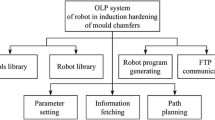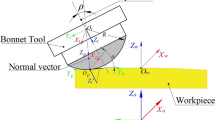Abstract
The quality of a braid preform generated by the braiding process is affected by the movement path and speed. Previous studies have obtained an optimal movement path and an efficient speed profile of the mandrel, but no studies have considered robot kinematics for the mandrel’s motion, thereby causing errors occur during the braiding process. This study developed an off-line programming system that generates an optimal mandrel movement path to produce a high-quality preform based on the 3D curvature shape of the mandrel. This movement path is then converted into a robot command. The via-points for the robot path generation were extracted from the mandrel surface geometry. Afterwards, the process of generating a continuous motion and rearranging the via-points for radial braiding was performed. Continuous motion was created by separating the straight and curved paths, and the via-point rearrangement was applied depending on the change in speed.
Similar content being viewed by others
Abbreviations
- α :
-
Braid angle
- ω :
-
Angular speed
- r m :
-
Mandrel radius
- v :
-
Moving speed of mandrel
- CP :
-
Cross-section
- g :
-
Center of gravity of the cross-section
- P :
-
Path point
- n :
-
Normal vector
References
G. Du and P. Popper, Analysis of a circular braiding process for complex shapes, The Journal of The Textile Institute, 85(3) (1994) 316–337.
J. F. A. Kessels and R. Akkerman, Prediction of the yarn trajectories on complex braided preforms, Composites Part A: Applied Science and Manufacturing, 33(8) (2002) 1073–1081.
J. H. Van Ravenhorst and R. Akkerman, Circular braiding take-up speed generation using inverse kinematics, Composites Part A: Applied Science and Manufacturing, 64 (2014) 147–158.
P. Monnot, J. Lévesque and L. L. Lebel, Automated braiding of a complex aircraft fuselage frame using a non-circular braiding model, Composites Part A: Applied Science and Manufacturing, 102 (2017) 48–63.
A. K. Pickett, J. Sirtautas and A. Erber, Braiding simulation and prediction of mechanical properties, Applied Composite Materials, 16(6) (2009) 345.
L. Chen, X. M. Tao and C. L. Choy, Mechanical analysis of 3-D braided composites by the finite multiphase element method, Composites Science and Technology, 59(16) (1999) 2383–2391.
W. J. Na, H. C. Ahn and S. Y. Jeon, Prediction of the braid pattern on arbitrary-shaped mandrels using the minimum path condition, Composites Science and Technology, 91 (2014) 30–37.
A. Fouladi et al., Control of braid pattern on every side of a braided composite part produced by asymmetrical braiding process, Applied Composite Materials, 26(2) (2019) 479–492.
T. Hans, J. Cichosz, M. Brand and R. Hinterhölzl, Finite element simulation of the braiding process for arbitrary mandrel shapes, Composites Part A: Applied Science and Manufacturing, 77 (2015) 124–132.
P. Neto and N. Mendes, Direct off-line robot programming via a common CAD package, Robotics and Autonomous Systems, 61(8) (2013) 896–910.
N. Larkin, A. Short, Z. Pan and S. Van Duin, Automatic weld path generation for mesh objects, Proc. of 2017 IEEE 7th Annual International Conference on CYBER Technology in Automation, Control, and Intelligent Systems, Honolulu (2017) 338–343.
S. Kwon, H. Kim and D. Mun, Multiobjective evolutionary optimization for feature-based simplification of 3D boundary representation models, International Journal of Advanced Manufacturing Technology, 110 (9) 2603–2618.
J. Polden, Z. Pan, N. Larkin, S. Van Duin and J. Norrish, Offline programming for a complex welding system using DELMIA automation, Robotic Welding, Intelligence and Automation, Springer, Berlin (2011) 341–349.
H. J. Choi, C. W. Park, K. J. Park and S. D. Choi, Analysis of automatic teaching position error to optimize OLP (off-line programming) for grinding/lapping robot system using laser tracker, Proc. of 2014 International Symposium on Optomechatronic Technologies, Seattle (2014) 264–267.
B. C. Kim, H. Lee, D. Mun and S. Han, Lifecycle management of component catalogs based on a neutral model to support seamless integration with plant 3D design, Journal of Computational Design and Engineering, 8(1) (2020) 409–427.
F. K. Ko, Braiding, Engineered Materials Handbook, Composites, ASM International, Metals Park, 1 (1987) 519–528.
R. Bernhardt, G. Schreck and C. Willnow, Realistic robot simulation, Computing and Control Engineering Journal, 6(4) (1995) 174–176.
Acknowledgments
This work was supported by the Autonomous Ship Technology Development Program (20011164, Development of Performance Monitoring and Failure Prediction and Diagnosis Technology for Engine System of Autonomous Ships) funded by the Ministry of Trade, Industry & Energy (MOTIE, Korea).
Author information
Authors and Affiliations
Corresponding author
Additional information
Jeongho Han is a Senior Engineer at Optimus System, Republic of Korea. He received his Ph.D. in Industrial Engineering from Ajou University in 2019. His research interests include geometric modeling, 3D simulation and virtual reality and augmented reality environment.
Jinwon Lee is a Postdoctoral Researcher in the School of Mechanical Engineering at Korea University, Seoul, Korea. He worked at Texas A&M University (college station, USA). He obtained his Ph.D. in Industrial Engineering in 2019 at Ajou University. His current research interests are neural networks, pattern recognition for industrial data, geometric modeling and virtual reality for engineering applications.
Jeongsam Yang is a Professor in the Department of Industrial Engineering and is leading the CAD Laboratory (http://cadlab.ajou.ac.kr) at Ajou University, Korea. He worked at Carnegie Mellon University (USA) and Clausthal University of Technology (Germany) as a researcher, and the University of Wisconsin-Madison (USA) as a postdoctoral associate. He obtained his Ph.D. in Mechanical Engineering in 2004 at KAIST. His current research interests are geometry modeling, VR application in product design, image pattern analysis, 3D model reconstruction, and computer graphics.
Rights and permissions
About this article
Cite this article
Han, J., Lee, J. & Yang, J. Development of a robot OLP system for the continuous motion control of a mandrel in the radial braiding process. J Mech Sci Technol 36, 3109–3117 (2022). https://doi.org/10.1007/s12206-022-0542-7
Received:
Revised:
Accepted:
Published:
Issue Date:
DOI: https://doi.org/10.1007/s12206-022-0542-7




